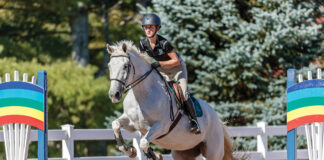Trotting fences can seem like a bit of a guessing game if you’re just learning to jump or are a timid rider. Seeing any distance (let alone the right one!) can seem impossible. The urge to throw yourself up your horse’s neck to stay out of the way can be almost overwhelming.
As the trot is slower than the canter, it gives riders a chance to refine their position and coordination and teaches the horse to balance and listen all the way to base of the fence.

Posting, Sitting or Half-seat?
Nori Scheffel, owner of Scheffelridge Farm in Paris, Ky., specializes in hunters and jumpers, teaching newbie riders and adult amateurs. Nori focuses heavily on getting riders to “feel the horse’s feet” when teaching them to jump or to instill confidence.
If a rider focuses on the hoof beats, counts one-two-one-two, and really thinks of the horse’s feet as their own, she will truly know when the take off is coming, and not get left behind or lean forward, Nori says. If a rider is not connected mentally to the horse and its footfalls, it will be harder for her to find the correct takeoff distance.
Approaching a fence at the posting trot can be difficult, as the rider’s position is constantly changing—it’s not simply riding in half- or full-seat, where the position is more stable. Most novice riders are still developing their sitting trot, so Nori prefers a solid positing trot to the fence until the rider is proficient at connecting their sitting trot for the last few strides before the fence.
The horse’s rhythm can be distracted by a bouncy rider, which can also be misinterpreted by the horse as a canter cue. Posting also allows riders to sink into their heels at the last step before takeoff, Nori notes.
Setting a Trot Fence
While trotting a fence can be as simple as setting the fence and going for it, another way to ensure trot-fence success is to use poles on the ground to help establish where a horse should place his feet.
One pole, called a placing pole, can be placed parallel to the jump, 8 to 9 feet away, giving the horse something to pay attention to instead of just the fence. If your horse is familiar and comfortable with trotting over poles, you can also set two trot poles before the placing pole, typically 4 to 4 1/2 feet apart.
The distance of the trot poles will be entirely dependent on your horse’s natural stride, so it may take some trial and error to find a distance he’s comfortable with.
Approaching at the Trot
The approach to a trot fence is no different than cantering to a fence, notes Nori. The goal is to establish a steady, even pace and trot all the way to the base of the fence, allowing your horse to jump out of stride, just like at the canter.
To take the jump well, you’ll need to arrive at the base of the fence both centered and in balance. This means you’ll need to look ahead, from point A to point B, whether that means you’re riding a line of two fences or simply wanting to travel straight toward and away from a fence.
Regardless of how hard you work on trot fences, if your horse is not warmed up properly, it will all be for naught, says Nori. The flat work riders use for warming up must be quality, not simply trotting around a certain number of times to get to the jumping part of the ride.
A horse that is prepared to jump is in front of the rider’s leg and reactive to aids, moving forward and coming back easily, before they are ever asked to jump a fence. A horse that is in front of a rider’s leg will not only have a better takeoff, but a better landing as well–not landing in a heap and losing all forward motion.







cool
Great advice.